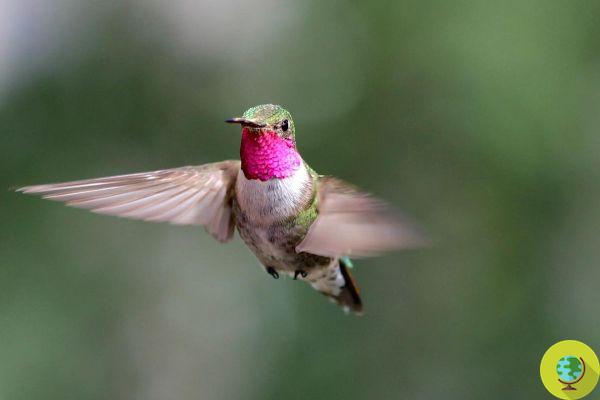
Research has investigated the fantastic color world of hummingbirds, confirming that they are also able to see ultraviolet (UV) color combinations
Hummingbirds see a world made of different colors that we humans cannot even imagine. To say a new study that has analyzed this special quality of hummingbirds, namely the ability to see even ultraviolet colors.
I broadtail hummingbird (Selasphorus platycercus) feature beautiful colorful and iridescent plumage but, even more striking, it appears to be what these beautiful birds are able to see.
Scientists have long known that birds likely have better color vision than humans. Like most primates, humans are trichromatic, meaning our eyes have three types of color-sensitive receptors or cones: blue, green and red. But birds have four color cones, and are therefore tetrachromatic.
We can therefore see the colors of the rainbow (spectral colors): red, orange, yellow, green, blue, indigo, violet but also a pure color (the only one not spooky) like real purple, because it stimulates our red and blue cones at the same time.
Birds can theoretically enjoy a wider range of colors, including the ultraviolet spectrum, which includes colors like UV green and UV red. But so far, researchers have done little research on what birds can actually see.
Now comes a new study, published in Proceedings of the National Academy of Sciences, which stars wild broad-tailed hummingbirds that live near the Rocky Mountain Biological Laboratory in Colorado.
The team of scientists, led by Mary Stoddard, an evolutionary biologist at Princeton University, revealed that these birds are able to discern various combinations of ultraviolet (UV) colors, allowing birds to see the world in additional colors that humans can't even imagine.
To achieve this, scientists studied hummingbirds every summer for three years. Their work has focused primarily on how hummingbirds perceive non-spectral colors, which are combinations of hues from widely separated parts of the color spectrum. A clear example of a non-spectral color is purple, which combines the blue and red wavelengths of light, but not green. Conversely, teal (blue-green) and yellow (green-red) are mixtures of neighboring colors in the spectrum.
In fact, as already mentioned, purple is the only non-spectral color that humans can perceive. But birds should theoretically be able to see up to five of them, thanks to their fourth cone.
To understand this, the research team carried out a series of experiments with wild hummingbirds (Selasphorus platycercus). In practice they made it available to him two feeders that they could use: one contained sugared water, the other only plain water.
The mangers were equipped with LED devices that transformed the color of the surface depending on whether the feeder contained sugared or plain water.
While at our glance both colors looked the same (green) for the hummingbirds this was not the case and they were therefore able to choose which feeder to go to.
The researchers swapped the positions of the most rewarding feeder to prevent birds from always going into the same and performed control experiments to rule out the influence of smell or any other indication unrelated to vision.
Hummingbirds always chose the manger with sugared water. Basically, the small birds of the Selasphorus platycercus species they saw the ultraviolet color, invisible to the human eye, which signaled the reward.
Over the course of 19 experiments, the researchers recorded over 6.000 visits to the manger. An analysis of hummingbird feeding patterns showed that birds can distinguish ultraviolet plus green from pure ultraviolet or pure green, as well as two different mixtures of ultraviolet plus red light (one more red, the other less). .
“It was fantastic to watch - said Harold Eyster, a University of British Columbia student and study co-author - The ultraviolet + green light and the green light looked identical to us, but the hummingbirds continued to choose the ultraviolet light correctly. green associated with sugar water. Our experiments allowed us to take a peek at the world seen by a hummingbird "
Fonti: National Geographic / PNAS
Read also:


























